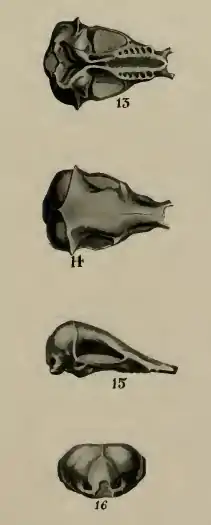Epoicotheriidae
Epoicotheriidae ("strange beasts") is an extinct family of pangolin-like insectivorous mammals which were endemic to North America from the early Eocene to the early Oligocene 55.8—30.9 Ma existing for approximately 24.9 million years .[1] Epoicotheriids were highly specialized animals that were convergent with the golden moles of Africa in the structure of their skulls and forelimbs, and would have had a similar lifestyle as subterranean burrowers.[2]
| Epoicotheriidae | |
|---|---|
 | |
| skull of Epoicotherium unicum | |
| Scientific classification | |
| Kingdom: | Animalia |
| Phylum: | Chordata |
| Class: | Mammalia |
| Order: | †Palaeanodonta |
| Family: | †Epoicotheriidae Simpson, 1927 |
| Genera[1] | |
| |
Classification and phylogeny
Taxonomy
Epoicotheriidae was named by Simpson in 1927. It was assigned to the Palaeanodonta by Rose (1978)[3] and Carroll (1988).
Classification
- Family: †Epoicotheriidae (Simpson, 1927)
- Genus: †Alocodontulum (Rose, 1978)
- †Alocodontulum atopum (Rose, 1977)
- Genus: †Auroratherium (Tong & Wang, 1997)
- †Auroratherium sinense (Tong & Wang, 1997)
- Genus: †Dipassalus (Rose, 1991)
- †Dipassalus oryctes (Rose, 1991)
- Genus: †Pentapassalus (Gazin, 1952)
- †Pentapassalus pearcei (Gazin, 1952)
- †Pentapassalus woodi (Guthrie, 1967)
- Genus: †Tubulodon (Jepsen, 1932)
- †Tubulodon taylori (Jepsen, 1932)
- Subfamily: †Epoicotheriinae (Simpson, 1927)
- Genus: †Epoicotherium (Simpson, 1927)
- †Epoicotherium unicum (Douglass, 1905)
- Genus: †Molaetherium (Storch & Rummel, 1999)
- †Molaetherium heissigi (Storch & Rummel, 1999)
- Genus: †Tetrapassalus (Simpson, 1959)
- †Tetrapassalus mckennai (Simpson, 1959)
- †Tetrapassalus proius (West, 1973)
- Genus: †Xenocranium (Colbert, 1942)
- †Xenocranium pileorivale (Colbert, 1942)
- Genus: †Epoicotherium (Simpson, 1927)
- Genus: †Alocodontulum (Rose, 1978)
Phylogenetic tree
The phylogenetic relationships of Epoicotheriidae are shown in the following cladogram:[4][5][6]
| Pholidotamorpha |
| ||||||||||||||||||||||||||||||||||||||||||||||||||||||||||||||||||||||||||||||||||||||||||||||||||||||||||||||||||||||||||||||||||
(Pholidota sensu lato) | |||||||||||||||||||||||||||||||||||||||||||||||||||||||||||||||||||||||||||||||||||||||||||||||||||||||||||||||||||||||||||||||||||
References
- "Classification of the family Epoicotheriidae". Paleobiology Database. Retrieved 10 December 2013.
- Kenneth D. Rose, Robert J. Emry (1983) "Extraordinary fossorial adaptations in the oligocene palaeanodonts Epoicotherium and Xenocranium (Mammalia)" Journal of Morphology 175(1):33 - 56
- Rose, Kenneth D. (1978). "A New Paleocene Epoicotheriid (Mammalia), with Comments on the Palaeanodonta". Journal of Paleontology. 52 (3): 658–674. JSTOR 1303970.
- Kenneth D. Rose (2008). "Palaeanodonta and Pholidota". In Janis, Christine M; Gunnell, Gregg F; Uhen, Mark D (eds.). 9 - Palaeanodonta and Pholidota. pp. 135–146. doi:10.1017/CBO9780511541438.010. ISBN 9780511541438.
- Gaudin, Timothy (2009). "The Phylogeny of Living and Extinct Pangolins (Mammalia, Pholidota) and Associated Taxa: A Morphology Based Analysis" (PDF). Journal of Mammalian Evolution. Heidelberg, Germany: Springer Science+Business Media. 16 (4): 235–305. doi:10.1007/s10914-009-9119-9. S2CID 1773698.
- Kondrashov, Peter; Agadjanian, Alexandre K. (2012). "A nearly complete skeleton of Ernanodon (Mammalia, Palaeanodonta) from Mongolia: morphofunctional analysis". Journal of Vertebrate Paleontology. 32 (5): 983–1001. doi:10.1080/02724634.2012.694319. ISSN 0272-4634. S2CID 86059673.